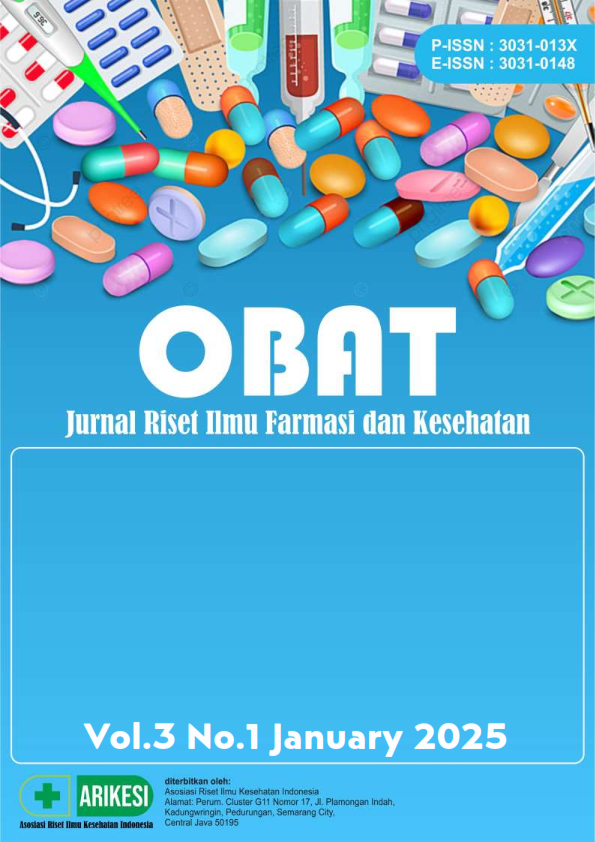Artikel Review: Formulasi Sediaan Tetes Mata untuk Mata Kering
DOI:
https://doi.org/10.61132/obat.v3i1.1036Keywords:
Dry Eyes, Eye Drops, FormulationAbstract
Eye drops are used for dry eyes, red eyes, allergies, infections, and glaucoma. Evaluation of eye drops includes pH, osmolality, and viscosity, which must be adjusted so that the preparation is comfortable for the eyes and does not cause irritation. This review aims to determine the active ingredients that are suitable for use and the efficacy of these active ingredients in eye drops that are made. Literature searches were conducted using online-based literature search instruments, such as Google Scholar. The results and discussions include several physical and chemical evaluations from several journals. Based on the literature study conducted, it can be concluded that various formulation innovations for the treatment of dry eyes, including lipid-based liposomes, omega-3 fatty acids, and natural ingredients such as castor oil, show great potential in mimicking the function of the natural tear film, reducing fluid evaporation, and supporting regeneration and stability of corneal epithelial cells.
Downloads
References
Aqil, M., Ali, A., & Ahad, A. (2012). Emerging nanotechnology for delivery of ophthalmic drugs. Therapeutic Delivery, 3(4), 395–407. https://doi.org/10.1358/dot.2011.47.6.1549023
Jacobi, C., Angstmann-Mehr, S., Lange, A., & Kaercher, T. (2022). A water-free omega-3 fatty acid eye drop formulation for the treatment of evaporative dry eye disease: A prospective, multicenter non-interventional study. Journal of Ocular Pharmacology and Therapeutics, 38(5), 348–353. https://doi.org/10.1089/jop.2021.0102
Jäntti, J., Viitaja, T., Sevón, J., Lajunen, T., Raitanen, J.-E., Schlegel, C., Viljanen, M., Paananen, R. O., Moilanen, J., Ruponen, M., & Ekholm, F. S. (2023). Early-stage development of an anti-evaporative liposomal formulation for the potential treatment of dry eyes. ACS Pharmacology & Translational Science, 6(10), 1518–1530. https://doi.org/10.1021/acsptsci.3c00147
Kim, S. J., Park, B., Huh, H. W., Na, Y. G., Kim, M., Han, M., Lee, H., Pham, T. M. A., Lee, H. K., Lee, J. Y., Kim, C. S., Baek, J. S., & Cho, C. W. (2020). Achyranthis radix extract-loaded eye drop formulation development and novel evaluation method for dry eye treatment. Pharmaceutics, 12(2), 165. https://doi.org/10.3390/pharmaceutics12020165
Kumari, S., & Singh, K. (2024). Formulation and in vitro evaluation of eye drop for dry eye syndrome. International Journal of Pharmaceutical Sciences, 2(6), 1179–1195. https://doi.org/10.5281/zenodo.12559083
Lang, J. C. (1995). Ocular drug delivery: Conventional ocular formulations. Advanced Drug Delivery Reviews, 16(1), 39–43.
Vicario-de-la-Torre, M., Caballo-González, M., Vico, E., Morales-Fernández, L., Arriola-Villalobos, P., De Las Heras, B., Benítez-Del-Castillo, J. M., Guzmán, M., Millar, T., Herrero-Vanrell, R., & Molina-Martínez, I. T. (2018). Novel nano-liposome formulation for dry eyes with components similar to the preocular tear film. Polymers, 10(4), 425. https://doi.org/10.3390/polym10040425
Wilson, S. E., & Hong, J. (2020). Clinical and molecular aspects of dry eye disease. International Ophthalmology Clinics, 60(3), 47–58. https://doi.org/10.1097/IIO.0000000000000332
Yang, C. Y., Lee, C. H., & Tseng, C. L. (2018). Recent advances in ocular drug delivery for the treatment of dry eye disease. Pharmaceutics, 10(3), 59. https://doi.org/10.3390/pharmaceutics10030059
Zhou, Q., & Wei, Y. (2023). Advances in nanotechnology for the development of artificial tears. Nanomedicine, 18(1), 25–38. https://doi.org/10.2217/nnm-2022-0351
Downloads
Published
How to Cite
Issue
Section
License
Copyright (c) 2025 OBAT: Jurnal Riset Ilmu Farmasi dan Kesehatan

This work is licensed under a Creative Commons Attribution-ShareAlike 4.0 International License.





